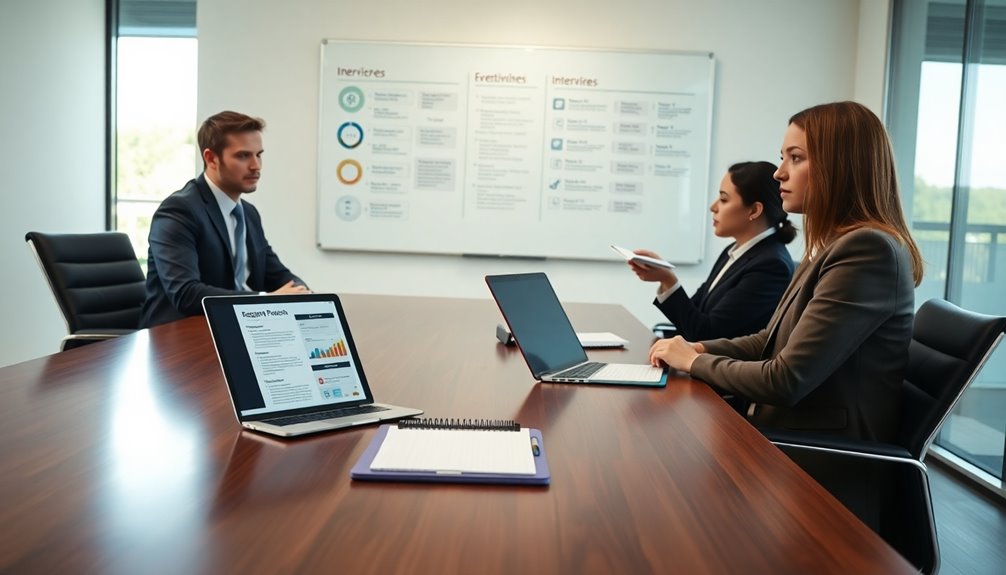To conduct a perfect interview, start by creating a welcoming atmosphere and preparing a structured script. Outline your interview's duration and key questions to reduce candidate anxiety. Use a mix of open-ended and behavioral questions, applying the STAR method for in-depth responses. Engage actively with candidates through eye contact and positive body language. Encourage them to ask questions, fostering a two-way conversation. After the interview, provide clear next steps and constructive feedback. By refining your approach continuously, you'll enhance your interviewing skills. Stick around to discover more tips for transforming your interview process into a smooth experience.
Key Takeaways
- Create a welcoming atmosphere with positive body language and tidiness to ease candidate nerves and foster engagement.
- Use a structured interview script that includes diverse question types to ensure clarity and fairness throughout the process.
- Employ the STAR method to encourage detailed responses, assessing candidates' past experiences and problem-solving skills effectively.
- Actively listen and encourage candidates to ask questions, promoting meaningful dialogue and transparency during the interview.
- Provide timely post-interview feedback and clarity on next steps to maintain candidate interest and enhance the organization's reputation.
Preparing for the Interview

When preparing for an interview, it is crucial to create an inviting atmosphere that reflects your company's values. A tidy office environment can greatly influence candidates' perceptions, so make certain your space is clean and organized. Turn off cell phones and minimize distractions to maintain focus during the interview. This allows both you and the candidates to engage fully, making for a more effective interview.
Start by preparing a brief introduction about yourself and the company. This sets a welcoming tone and provides context for the candidates. Clearly outline the interview's duration and structure, helping them understand the flow and what to expect. This transparency can ease any nerves and promote a more relaxed conversation.
As you interact, remember that your demeanor reflects your company culture. Candidates often assess cultural fit based on your professionalism and attitude. By embodying the values you want to promote, you set the standard for what candidates can expect from your organization. This preparation not only guarantees a smooth hiring process but also helps you attract the right talent who resonates with your company's mission and values.
Creating a Structured Interview Script

A structured interview script brings clarity and fairness to the hiring process, ensuring every candidate is evaluated on the same criteria. Start by outlining the key areas you want to explore, using the candidates' resumes as a reference. Include a mix of question types—open-ended, close-ended, hypothetical, and behavioral questions—to gain extensive insights into each candidate's skills and experiences.
Incorporate the STAR method (Situation, Task, Action, Result) within your script to elicit detailed responses that reveal candidates' problem-solving abilities and past performance. This approach allows you to gather specific examples, which can be essential for making an informed hiring decision.
Don't forget to include some icebreaker questions at the beginning of your script. These help ease candidates into the conversation, creating a more comfortable interview atmosphere. By using a standardized script, you minimize unconscious biases, focusing on relevant qualifications instead of personal impressions or unrelated factors. Ultimately, a well-crafted structured interview script not only enhances your evaluation process but also helps you make fairer and more consistent hiring decisions.
Conducting Candidate Assessments

How can you guarantee a complete evaluation of candidates beyond their resumes? By implementing a combination of skills testing, the STAR method, and interview scorecards. This approach allows you to assess candidates' personality, cognitive ability, and role-specific skills effectively.
Start with pre-recorded video responses during the initial screening to gauge communication skills and confidence. During in-person interviews, use the STAR method to prompt structured responses that highlight problem-solving abilities. Here's a quick reference table to help you focus your assessments:
| Assessment Method | Purpose |
|---|---|
| Skills Testing | Evaluate practical abilities |
| STAR Method | Encourage detailed, structured answers |
| Interview Scorecards | Guarantee objective candidate comparison |
Incorporate active listening techniques to deepen your understanding and minimize bias. By combining these elements, you're not just checking boxes; you're building a thorough picture of each candidate. This way, you enhance the accuracy of your candidate assessments and make informed hiring decisions.
Engaging With Candidates

Creating a welcoming atmosphere during interviews sets the stage for genuine engagement with candidates. Use positive body language, like smiling and maintaining eye contact, to build rapport and ease their nerves. This simple approach makes candidates feel valued and comfortable, paving the way for more open communication.
Implement active listening techniques throughout the conversation. Allow candidates to express their thoughts fully, aiming for an 80/20 listening-to-talking ratio. This fosters meaningful dialogue and shows you're genuinely interested in what they have to say. Encourage candidates to ask questions about the role and company; this not only gauges their interest but also offers insights into their preparedness and alignment with your organization.
When candidates do inquire, tailor your responses with clear and confident answers. This reinforces transparency and builds trust. Utilize follow-up questions to explore deeper into their experiences and thoughts, enhancing engagement and uncovering valuable insights about their qualifications and fit for the role. By prioritizing engagement, you create a positive interview experience that benefits both you and the candidates.
Asking the Right Questions

Asking the right questions is essential for getting the insights you need from candidates. You should mix open-ended and tailored questions while using behavioral inquiry techniques to uncover their skills and experiences effectively. By doing so, you'll create a more dynamic conversation that reveals the candidate's true potential. Additionally, incorporating questions that assess emotional intelligence can provide deeper insights into a candidate's adaptability and team management skills.
Open-Ended Questions
When it comes to interviewing, incorporating open-ended questions is essential for uncovering a candidate's true potential. These questions encourage candidates to provide detailed responses, allowing you to gain deeper insights into their experiences and thought processes.
To make the most of your interview process, consider these strategies:
- Start with prompts like "Tell me about your greatest challenge."
- Focus on the job description to tailor your questions, ensuring relevance.
- Encourage storytelling to reveal their problem-solving abilities and interpersonal skills.
When you ask candidates open-ended questions, you not only facilitate a more engaging dialogue but also make them feel valued and comfortable sharing their perspectives. This approach helps you assess their cultural fit within your organization. Remember to craft questions that avoid leading candidates toward specific answers, maintaining objectivity in your evaluation process.
Behavioral Inquiry Techniques
To effectively evaluate a candidate's fit for your organization, employing behavioral inquiry techniques is essential. These techniques focus on understanding a candidate's past experiences and actions to predict how they'll perform in similar situations. Using the STAR method—where candidates outline the Situation, Task, Action, and Result—helps you structure your questions and encourages candidates to articulate their experiences clearly.
Incorporate open-ended questions like, "Can you describe a time when you faced a challenge at work?" This prompts candidates to share detailed responses, showcasing their problem-solving skills and how they handle adversity. Balancing these with situational questions can reveal how a candidate might tackle hypothetical scenarios relevant to the role. For instance, ask, "What would you do if you had a tight deadline and conflicting priorities?"
Finally, don't forget to regularly review and update your behavioral questions. Keeping them relevant to evolving job requirements and your company culture guarantees that you're effectively evaluating candidates. By implementing these behavioral inquiry techniques, you'll be better equipped to determine which candidates will thrive in your organization.
Tailored Candidate Questions
Interview questions should align with each candidate's unique background and experiences, allowing you to assess their fit for the role more accurately. By crafting tailored interview questions, you can dig deeper into their skills and thought processes. Here's how to do it effectively:
- Use a mix of open-ended and close-ended questions.
- Implement behavioral questions using the STAR method (Situation, Task, Action, Result).
- Ask follow-up questions to encourage elaboration.
Tailored interview questions help you uncover valuable insights about candidates. Behavioral questions are particularly useful as they prompt candidates to share real-life experiences, showcasing their problem-solving abilities. After they respond, don't hesitate to ask follow-up questions. This will help you gain a clearer understanding of their thought processes and decision-making skills.
While it's crucial to personalize your questions, maintain a consistent set across all candidates. This guarantees fairness and comparability during the evaluation process. By employing these techniques, you'll not only assess fit more accurately but also create a more engaging interview environment. Remember, the right questions can reveal hidden strengths and potential red flags in candidates.
Building Rapport and Comfort

To build rapport and comfort during your interview, start with a few icebreaker questions that help ease the candidate into the conversation. This sets a positive atmosphere and encourages open dialogue. Remember, your body language matters—smiling and maintaining eye contact can go a long way in making candidates feel welcome. Additionally, fostering a culture of experimentation and risk-taking can help candidates feel more at ease to express their thoughts and ideas.
Icebreaker Questions
Creating a relaxed atmosphere at the start of an interview can greatly enhance the experience for both you and the candidate. Icebreaker questions are a fantastic way to achieve this, as they help candidates feel comfortable and engaged right from the start. By incorporating these questions, you set the stage for a more open and effective interview process.
Consider using icebreaker questions that touch on light-hearted topics or personal interests. Here are some examples:
- "What's your favorite way to spend a weekend?"
- "If you could travel anywhere in the world, where would it be?"
- "What's a fun fact about yourself that most people don't know?"
These questions not only lighten the mood but also encourage candidates to share more about themselves, fostering rapport. Establishing a connection early on can reduce anxiety for both you and the candidates, leading to a more productive conversation. Research shows that this early rapport positively influences candidates' perceptions of your company, making them more likely to engage meaningfully throughout the interview process. So go ahead, break the ice and create a comfortable atmosphere!
Positive Atmosphere
Setting the stage for a positive atmosphere during your interview can make a world of difference in how candidates connect with you. When you create a welcoming environment, candidates feel less anxious and more at ease to express themselves authentically. Start with icebreaker questions to ease them into the conversation; this helps build rapport right from the beginning.
Maintaining eye contact and using positive body language, like smiling and nodding, fosters a sense of comfort. This encourages candidates to engage more fully in the discussion. Remember, an interview should be a two-way process. Allowing candidates to ask their own questions not only empowers them but also demonstrates that you value their input, reinforcing the idea that this is a dialogue rather than a one-sided evaluation.
Additionally, pay attention to the physical space. A tidy environment with refreshments can greatly enhance the candidate experience. When candidates feel comfortable in their surroundings, it reflects positively on your organization. By focusing on these elements, you can cultivate a positive atmosphere that encourages open communication and connection during the interview. Furthermore, fostering a supportive environment can help mitigate any trust issues that may arise from the interview process.
Taking Effective Notes

During interviews, effective note-taking can be the key to capturing the essence of each candidate's responses. Jotting down important details not only helps you remember each individual's strengths and weaknesses but also streamlines the review process later on. Here are some tips to enhance your note-taking:
- Use concise keywords and phrases to capture key points efficiently.
- Organize your notes by candidate to simplify tracking thoughts and impressions.
- Consider employing HR automation tools or AI note-takers for increased efficiency.
Communicating Next Steps

After the interview, you need to clearly communicate the next steps in the recruitment process. Let candidates know when they can expect feedback and what additional stages might involve. This transparency not only keeps them engaged but also leaves a positive impression of your organization.
Timeline for Candidate Updates
How can you guarantee candidates feel valued throughout the interview process? A clear timeline for candidate updates is essential. Right after the interview, communicate what candidates can expect regarding feedback and next steps in the recruitment process. This transparency not only sets expectations but also keeps them engaged.
Here are three key points to remember:
- Feedback Timeline: Let candidates know they'll hear back within a week about their application status.
- Next Steps: Inform them if there are additional interviews or assessments required.
- Handling Delays: If there are any delays, keep candidates in the loop and explain the reasons behind them.
Next Steps Clarification
Once candidates are informed about the feedback timeline and any potential delays, it's time to clarify the next steps in the recruitment process. This next steps clarification is vital for setting the right expectations. Clearly outline what candidates can anticipate, including when they'll hear back from you. Make certain to provide a specific timeline for feedback, so they know exactly when to expect updates.
Transparency is key, so explain the criteria used for evaluation. Let candidates know how you'll assess their fit for the role, which can help alleviate any uncertainty. Additionally, guarantee that they have access to your contact information for follow-up questions. This maintains open lines of communication, encouraging candidates to reach out if they need clarity.
Finally, emphasize the importance of timely updates. Prolonged hiring processes can lead to losing interest from up to 60% of applicants. By keeping the process moving and providing regular updates, you'll not only maintain candidate interest but also enhance your organization's reputation. Clarity, transparency, and communication are your best tools in this stage of recruitment.
Post-Interview Evaluation

The post-interview evaluation is essential for guaranteeing a fair and effective hiring process. After the interviews, take the time to assess each candidate using a structured approach. Here's how to make your evaluation more impactful:
- Collaborate with fellow interviewers to discuss insights and impressions.
- Document outcomes and feedback for future reference.
- Provide constructive feedback to unsuccessful candidates.
Start by using scorecards to conduct a uniform evaluation of candidates based on established criteria. This guarantees you make consistent comparisons. Collaborating with your team enhances the assessment, as different perspectives can lead to a more thorough understanding of each candidate's suitability for the role.
Don't forget to document the outcomes, which will help refine your hiring process for the future. Transparency is key, so communicate timelines for follow-up and feedback promptly. This not only reinforces engagement but also helps maintain a positive candidate experience, reflecting well on your company's reputation. Additionally, consider integrating financial planning strategies to better manage any costs associated with hiring processes. By prioritizing these steps, you'll create an organized and fair post-interview evaluation that benefits everyone involved.
Finalizing the Hiring Decision

What steps will you take to finalize your hiring decision after conducting interviews? Start by gathering all data collected during the interview process. Review the candidates' responses, skills assessments, and any feedback from other interviewers to guarantee you have a complete picture. A standardized scoring system or scorecard can help you objectively compare candidates based on established criteria, reducing bias in your decision-making.
Next, conduct a final discussion among all interviewers. This is your chance to share insights, address any concerns, and reach a consensus on the preferred candidate for the role. Once you've made your hiring decision, it's vital to outline the next steps for the selected candidate. Clearly communicate timelines for job offers and onboarding procedures to maintain their engagement and enthusiasm.
Lastly, document the reasons for your hiring decision. Providing feedback to non-selected candidates not only supports transparency but also aids in continuous improvement for future recruitment efforts. By following these steps, you can finalize your hiring decision efficiently and effectively, guaranteeing a smooth shift for everyone involved.
Frequently Asked Questions
How Do You Conduct an Interview Step by Step?
To conduct an interview step by step, start by scheduling it in advance and giving candidates notice to prepare. Create a comfortable environment with the right setup. Follow a structured format: introduce yourself, share job details, ask your questions, and allow candidates to ask theirs. Use standardized questions for fairness but be open to follow-ups. Finally, summarize key points, outline next steps, and thank the candidate for their time and interest.
What Are the 7 Steps in an Interview?
When you think about the interview's structure, you might see it as a simple Q&A, yet it's a complex dance of engagement. First, you identify the purpose, then plan ahead. Next, you create a welcoming environment. As the interview unfolds, follow a structured format with varied questioning techniques. Finally, wrap up by outlining next steps. Each step interconnects, ensuring you assess candidates effectively while keeping the process transparent and respectful.
How to Do a Perfect Interview?
To conduct a perfect interview, start by creating a welcoming atmosphere. Offer refreshments and engage in small talk to ease nerves. Use a structured format to cover all essential topics efficiently. Mix questioning techniques, focusing on both behavioral and open-ended questions to gain deeper insights. Listen more than you talk, maintaining an 80/20 ratio. Finally, clearly outline the next steps in the process to keep candidates informed and engaged.
What Are the Six 6 Steps in Conducting an Interview?
Conducting an interview isn't just about asking questions; it's about creating a connection. Start by identifying your purpose to guide your questions. Then, plan and prepare meticulously, ensuring all details are sorted. Set ground rules to foster comfort, and use positive body language to encourage openness. Finally, conclude effectively by summarizing key points and thanking the candidate, leaving them with a positive impression of the entire experience.
Conclusion
By following this step-by-step guide, you'll streamline your interview process and enhance your candidate experience. You might worry that sticking to a script feels robotic, but remember: it's just a guide. Think of it as a map that helps you navigate the conversation while still allowing room for spontaneity. This balance keeps interviews engaging and effective, ultimately leading you to the right hire. Embrace these strategies, and watch your recruitment process transform!
Felicity, our Author, pens in-depth articles and guides that delve into the heart of personal discovery. Her narrative-driven approach weaves together theory, practice, and personal anecdotes, making the journey of self-exploration both relatable and inspiring. Felicity’s contributions help illuminate the path for those seeking a deeper understanding of themselves and their relationships.










